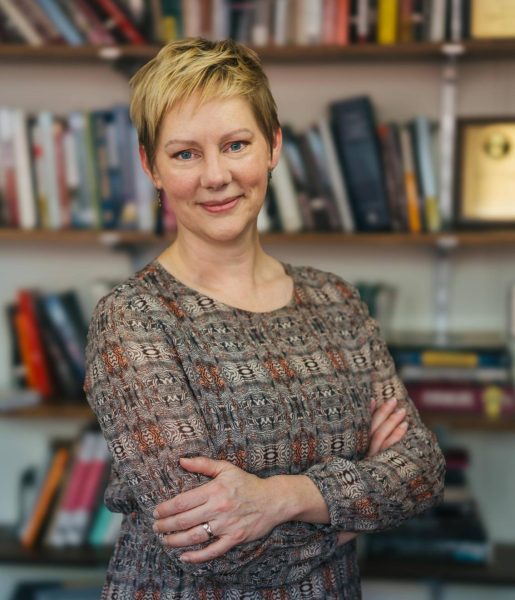Movie Review: ‘Scary Stories To Tell in the Dark’
“Scary Stories To Tell in the Dark” follows a group of teenagers. In the small town of Mill Valley, the legend of Sarah Bellows looms large. According to legend, Bellows was a devilish female, whose antics led to the death of many children. On Halloween night, a band of youths enter the Bellows household, hoping to find something interesting. Eventually, they stumble across a book containing Bellows’ horror stories. At first, all appears to be well. But as time moves on, local teens begin to disappear. If the group of teenagers are going to survive, they must find out the facts regarding Bellows’ mythologized history.
Based on Alvin Schwartz’s iconic series, this flick is a successful adaptation. The film’s atmosphere is wonderfully effective. Mill Valley feels cozy. From the get-go, we witness the town’s small, tight-knit nature. It’s a film in which different groups constantly run into the other, due to small-town geography. Like “Halloween” and “It,” the contamination of small-town America proves to be ideal for horror trappings. Everyone knows everyone, so when crap hits the fan, there is a genuine sense of panic. From a communal perspective, the tragedies that transpire feel deeply personal.
Like many small towns, Mill Valley has haunted house folklore, which allows imaginations to run wild. The haunted house is a massively engaging structure, filled with gothic sensibilities. It seems larger than life. Credit must be given to the cast and crew for creating a believable environment, set in 1968, a year in which the horrors of Vietnam were in full swing. David Brisbin’s production design manages to bring the harsh Vietnam era to cinematic life.
Once again, Andre Øvredal (the director) has crafted an enjoyable flick. In past years, Øvredal has proven himself to be a talented horror filmmaker. In 2010, he wrote and directed “Trollhunter,” a found footage film unlike any other. Then, in 2016, Øvredal directed “The Autopsy of Jane Doe,” a supernaturally charged tale of terror. Overall, Øvredal’s work points to a massive appreciation of horror fiction. Thus, in “Scary Stories To Tell in the Dark,” there is an abundance of respect for horror storytelling at large.
We see posters of Bella Lugosi, an icon of horror, widely known for his portrayal of Dracula. We see glimpses of George Romero’s “Night of the Living Dead,” a legendary film, often praised for its social progressiveness and brutal honesty. But most importantly, the power of horror is embedded into the film’s main character, Stella. Because of familial separation, the character of Stella holds onto an abundance of pain. Ultimately, this pain is exercised through forms of creative writing. Øvredal understands the power of expression, and the end result is a film that displays the magical nature of creativity. In a world where unfairness runs wild, the prism of storytelling allows us to inspire ourselves and the world at large. This much is seen through Stella’s story.
Dan and Kevin Hageman get screenplay credit. Their script takes pride in allowing the characters to have somewhat distinctive voices. Every character has a fundamental personality, setting the stage for compelling group dynamics. Every character within the main group has a chance to shine. As a whole, this cast has terrific chemistry. These friendships feel fully formed, and that’s a testament to the screenwriters and cast.
As Stella, Zoe Margaret Colletti successfully portrays the most well-rounded character within the narrative. Her sweetness and poignant underpinnings create a heartfelt arc, consisting of believability. As Ramon, Michael Garza’s performance is sure to stir the emotions surrounding real life horrors, such as war, racism and misguided politics. At its core, this story is about the baggage that comes with being a human being born into an unfair world. Credit must be given to the Hageman brothers for humanizing the primary characters. Yes, these children are dealing with supernatural forces. But overall, Stella and Ramon’s humanistic experiences create appealing identities, designed to spark a sense of emotional resonance. And from there, we are willing to embark on this spooky journey.
Guillermo del Toro, a massive fan of monsters, has a history of brining iconic monstrosities to the big screen. Consider these titles: “Pan’s Labyrinth,” “Hellboy,” “Hellboy II: The Golden Army,” “Pacific Rim” and “The Shape of Water.” Every title features highly impressive monsters, brimming with imagination. Even though Guillermo del Toro is just a producer (on this film), our monstrous expectations are sky high. After all, this is the man who produced monster hits, such as “The Orphanage” and “Mama.”
In Øvredal’s flick, the monsters are astonishing. Back in the day, Stephen Gammell created the beautifully scary portraits found within Schwartz’s stories. To this day, his illustrations continue to inspire art enthusiasts. In this film, Gammell’s visual creations are perfectly recreated. Every monstrous creation feels like it has been ripped from the depths of Gammell’s imagination. Consequently, these cinematic monsters are beacons of terror, fueled by artistic detail and timeless nostalgia.
Øvredal’s affinity for horror shines brightest during the set pieces. Every single set piece generates excitement. The PG-13 rating perfectly parallels the original novels’ kid friendly atmosphere. As a horror fan, it’s a breath of fresh air to see a filmmaker utilize scares in natural, non-violent ways. Simply put, Øvredal knows what scares us. Whether if it’s a horde of spiders, a mysterious insect bite, an identified object stuck in a bowl of food, or a judgmental society, Øvredal’s aspects of horror tap into real life phobias.
Sadly, after a while, the supporting characters’ antics are tiresome. In terms of emotional depth, the supporting characters lack a pulse. Their cinematic existence creates many moments of humor, but as time goes on, it’s just more of the same. Their personalized demons aren’t explored, and as a result, we are unable to connect with their inner fears. Thus, when the monsters come calling, the tense confrontations lack an emotional punch. If the script were to expand its emotional range, the story would be even more impactful.
While the story as a whole works, there are a lot of rough patches. In particular, much of the narrative is dedicated to investigating the Bellows family. These ensuing revelations become extremely repetitive. On a consistent basis, we are forced to endure uninteresting bits of exploration. Characters find information, enabling them to relay chunks of exposition, lacking strength and vitality. Ultimately, in spots, the story has traces of clunkiness, and overall, the film ends up feeling longer than it actually is. The finale, which wraps up specific character arcs, is fine, but in retrospect, it’s a bit sloppy and anticlimactic.
In conclusion, I recommend “Scary Stories To Tell in the Dark.” It’s been a solid summer, filled with horror movies left and right. As we have seen many times beforehand, the key to making a good horror film is getting a great filmmaker. Øvredal is one of the best horror directors working today, and with this film, he crafts a narrative that stands on its own. But at the same time, Øvredal’s film so brilliantly sets up an entire world of possibilities. The future is uncertain, but as a massive fan of horror, I hope that “Scary Stories To Tell in the Dark” continues to endure on the silver screen. Horror fans, you can rest easy. Love has been put into this adaptation!
My Grade: B+
Dillon McCarty can be contacted at [email protected].
Your donation will help continue the work of independent student journalism at Marshall University. If you benefit from The Parthenon's free content, please consider making a donation.






